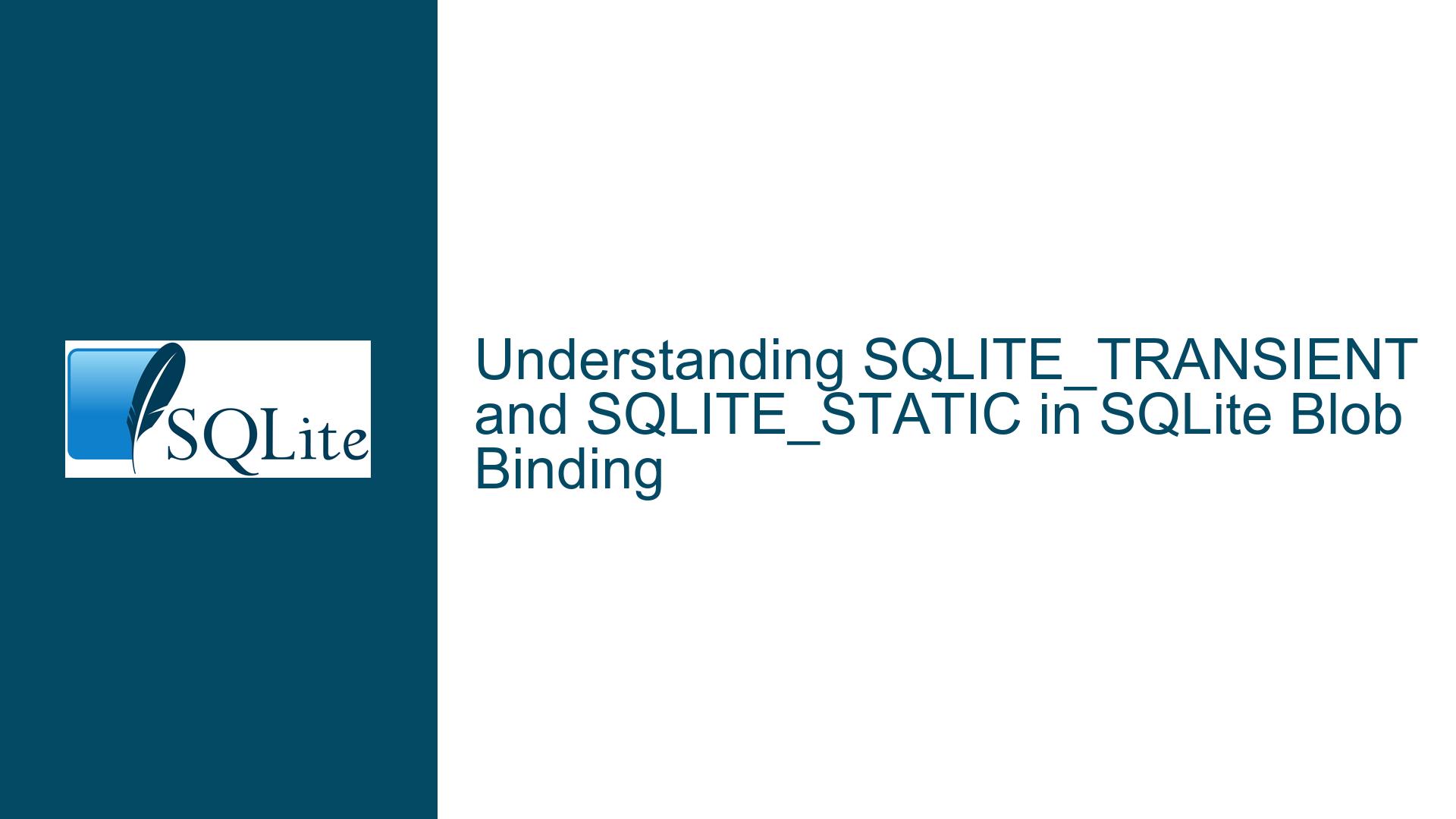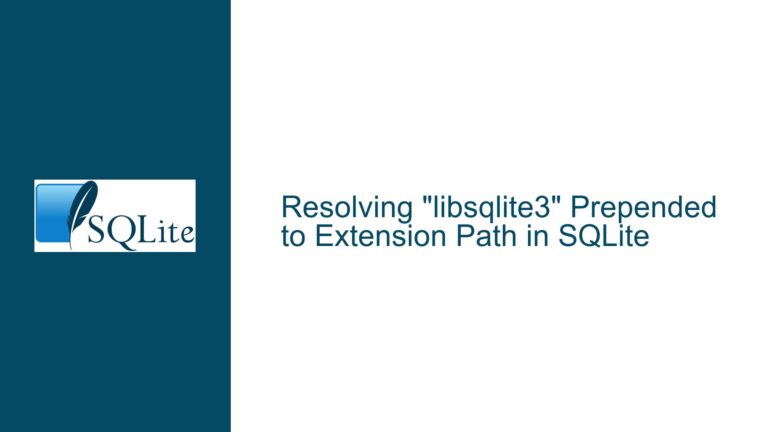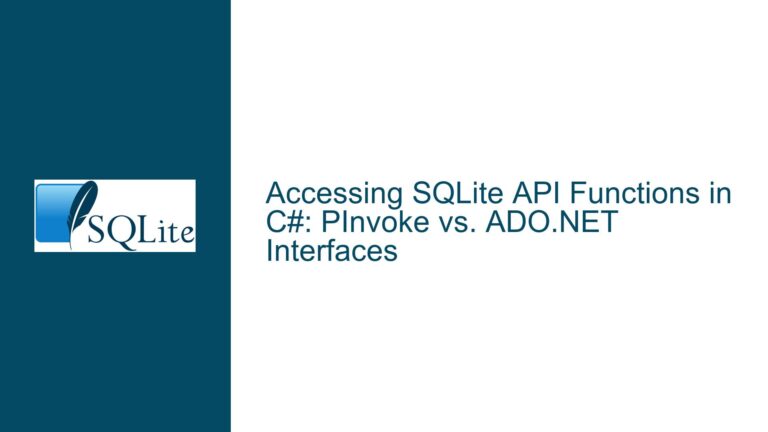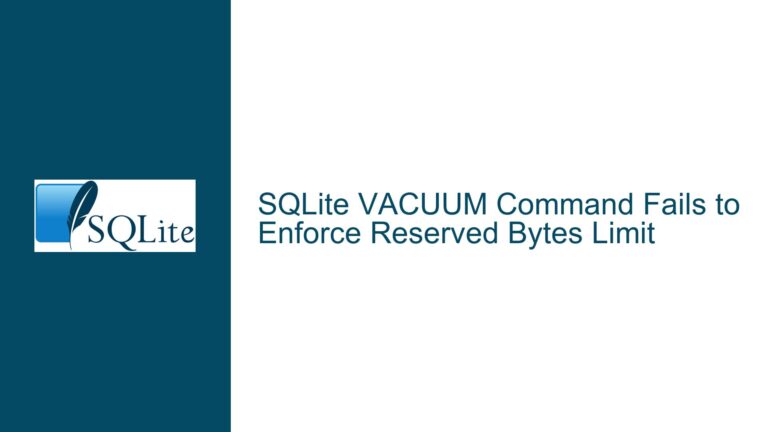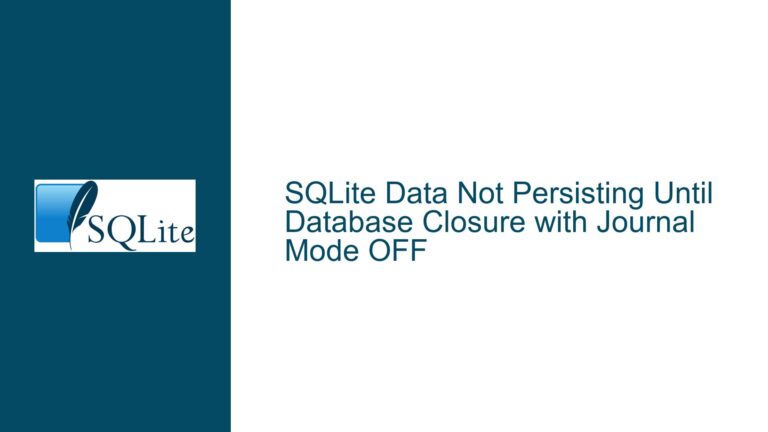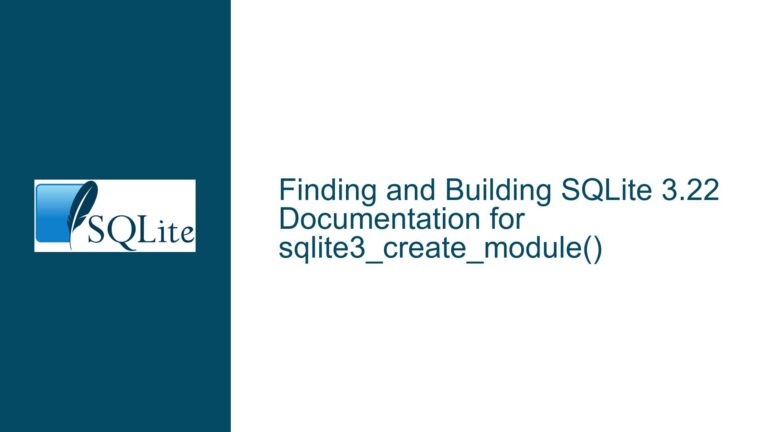SQLITE_TRANSIENT and SQLITE_STATIC in SQLite Blob Binding
SQLite Blob Binding: SQLITE_TRANSIENT vs. SQLITE_STATIC Behavior
When working with SQLite’s C/C++ API, particularly when binding binary large objects (BLOBs) to prepared statements, developers often encounter the need to manage memory efficiently while ensuring data integrity. The sqlite3_bind_blob() function is a critical tool for this purpose, but its behavior can be nuanced depending on the fifth argument passed to it: SQLITE_TRANSIENT or SQLITE_STATIC. This post delves into the intricacies of these two options, their implications for memory management, and how to use them effectively in your applications.
SQLITE_TRANSIENT: Immediate Private Copy for Safe Memory Management
The SQLITE_TRANSIENT option is designed to provide a straightforward way to bind BLOBs without worrying about the lifetime of the source data. When SQLITE_TRANSIENT is passed as the fifth argument to sqlite3_bind_blob(), SQLite creates an internal copy of the data immediately, before the function returns. This means that the caller is free to release or modify the original data buffer as soon as the function call completes, without affecting the bound data.
For example, consider the following C++ code snippet using std::unique_ptr to manage a memory stream:
std::unique_ptr<TMemoryStream> pUniqueMemStrm(new TMemoryStream);
pUniqueMemStrm->LoadFromFile(file);
sqlite3_bind_blob(&stmt, valueCount, pUniqueMemStrm->Memory, pUniqueMemStrm->Size, SQLITE_TRANSIENT);
In this case, pUniqueMemStrm can be safely deleted or reset immediately after the sqlite3_bind_blob() call, as SQLite has already made a private copy of the data. This behavior is particularly useful in scenarios where the source data is temporary or dynamically allocated, and the caller wants to avoid holding onto memory longer than necessary.
However, while SQLITE_TRANSIENT simplifies memory management, it comes with a performance cost. The internal copy operation can be expensive, especially for large BLOBs, as it involves allocating memory and copying data. This overhead can be significant in performance-critical applications or when dealing with large datasets.
SQLITE_STATIC: Avoiding Unnecessary Copies with Careful Lifetime Management
In contrast to SQLITE_TRANSIENT, the SQLITE_STATIC option assumes that the data pointer passed to sqlite3_bind_blob() remains valid for the duration of the SQLite operation. This means that SQLite does not create an internal copy of the data, relying instead on the caller to ensure that the data remains accessible until it is no longer needed by SQLite.
Using SQLITE_STATIC can lead to significant performance improvements, as it avoids the overhead of copying data. However, it requires careful management of the data’s lifetime to prevent undefined behavior or crashes due to accessing invalid memory. For example:
const char* staticData = "This is a static string";
sqlite3_bind_blob(&stmt, valueCount, staticData, strlen(staticData), SQLITE_STATIC);
In this case, staticData must remain valid until SQLite has finished using it. This typically means ensuring that the data is not freed or modified until after the prepared statement is finalized, reset, or rebound.
The challenge with SQLITE_STATIC lies in determining exactly when SQLite is "finished" with the data. According to the SQLite documentation, the data must remain valid until one of the following occurs:
- The bound parameter is rebound to a different value.
- The bound parameters are cleared using
sqlite3_clear_bindings(). - The prepared statement is finalized using
sqlite3_finalize().
This requirement can be tricky to manage, especially in complex applications where the lifetime of data buffers may not align neatly with SQLite operations. Misjudging the lifetime can lead to subtle bugs, such as accessing freed memory or data corruption.
Optimizing Blob Binding: Best Practices and Troubleshooting
To effectively use SQLITE_TRANSIENT and SQLITE_STATIC, developers must balance performance considerations with the need for robust memory management. Here are some best practices and troubleshooting steps to help you navigate these trade-offs:
1. Use SQLITE_TRANSIENT for Simplicity and Safety
When in doubt, SQLITE_TRANSIENT is the safer choice. It eliminates the need to manage the lifetime of the data buffer, reducing the risk of memory-related bugs. This is particularly useful in scenarios where the data is dynamically allocated or where the lifetime of the data buffer is difficult to predict.
For example, if you are loading data from a file or network stream and binding it to a prepared statement, SQLITE_TRANSIENT ensures that SQLite has its own copy of the data, allowing you to release the original buffer immediately:
std::unique_ptr<TMemoryStream> pUniqueMemStrm(new TMemoryStream);
pUniqueMemStrm->LoadFromFile(file);
sqlite3_bind_blob(&stmt, valueCount, pUniqueMemStrm->Memory, pUniqueMemStrm->Size, SQLITE_TRANSIENT);
pUniqueMemStrm.reset(); // Safe to release memory immediately
2. Use SQLITE_STATIC for Performance-Critical Applications
In performance-critical applications, SQLITE_STATIC can provide a significant boost by avoiding unnecessary data copies. However, this requires careful management of the data buffer’s lifetime. Ensure that the buffer remains valid until SQLite has finished using it, as described earlier.
One common approach is to use stack-allocated buffers or global/static variables for data that will be bound with SQLITE_STATIC. For example:
const char* staticData = "This is a static string";
sqlite3_bind_blob(&stmt, valueCount, staticData, strlen(staticData), SQLITE_STATIC);
In this case, staticData is a constant string that remains valid for the duration of the program, ensuring that SQLite can safely access it.
3. Use Custom Destructors for Fine-Grained Control
For scenarios where neither SQLITE_TRANSIENT nor SQLITE_STATIC is ideal, consider using a custom destructor function. This allows you to specify exactly when SQLite should release the data, providing fine-grained control over memory management.
For example, you can define a destructor function that frees the data buffer when SQLite is done with it:
void customDestructor(void* data) {
free(data);
}
char* dynamicData = (char*)malloc(100);
// Populate dynamicData with some data
sqlite3_bind_blob(&stmt, valueCount, dynamicData, 100, customDestructor);
In this case, dynamicData will be freed automatically when SQLite no longer needs it, eliminating the need to manually manage its lifetime.
4. Debugging Common Issues with Blob Binding
When working with SQLITE_TRANSIENT and SQLITE_STATIC, developers may encounter several common issues:
Data Corruption: If
SQLITE_STATICis used with a data buffer that is freed or modified before SQLite is done with it, the result can be data corruption or crashes. To diagnose this issue, ensure that the data buffer remains valid until the prepared statement is finalized, reset, or rebound.Performance Bottlenecks: Excessive use of
SQLITE_TRANSIENTcan lead to performance bottlenecks due to the overhead of copying data. If your application is experiencing performance issues, consider usingSQLITE_STATICor custom destructors to reduce unnecessary data copies.Memory Leaks: Failing to properly manage the lifetime of data buffers can lead to memory leaks. For example, if you use
SQLITE_STATICwith a dynamically allocated buffer but forget to free it after SQLite is done, the memory will not be reclaimed. Use tools like Valgrind or AddressSanitizer to detect and diagnose memory leaks.
5. Testing and Validation
To ensure that your use of SQLITE_TRANSIENT and SQLITE_STATIC is correct, thorough testing is essential. This includes:
Unit Tests: Write unit tests that cover various scenarios, including binding large BLOBs, using dynamically allocated buffers, and rebinding parameters. Verify that the data is correctly stored and retrieved from the database.
Stress Testing: Perform stress tests to evaluate the performance and stability of your application under heavy load. This can help identify issues related to memory management or performance bottlenecks.
Code Reviews: Conduct code reviews to ensure that the lifetime of data buffers is correctly managed and that the appropriate binding option (
SQLITE_TRANSIENTorSQLITE_STATIC) is used in each case.
By following these best practices and troubleshooting steps, you can effectively use SQLITE_TRANSIENT and SQLITE_STATIC in your SQLite applications, balancing performance and memory management to achieve optimal results.
